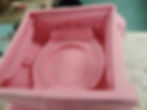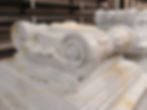
A Capital Idea
The scenery department at the Goodman had a problem. The set design for 2020's Roe required them to build a replica of the Supreme Court, including ten giant columns with capitals adorning the top of each one. Foam and fiberglass capitals found online were too small or not the right shape. They did manage to find a capital that looked identical to those found in the Supreme Court, and it was the right size. But, it was $300 and made of stone, weighing in at 75 lbs. each. The idea of hanging heavy stone capitals twenty feet above the actor's heads didn't seem like a good idea, so they came to me about making a mold and casting them out of foam.
After researching which materials, I decided to go with Mold Max 30 silicone to make the mold. My usual go to silicone is Mold Star 16, because it's fast setting and doesn't require degassing. But, this user friendly silicone is nearly twice as expensive. One of the scenic carpenters built a mother mold out of wood, and carved it to the contours of the capitals. But, due to the size of the capital itself, it would still require about six gallons of silicone. So, the cheaper silicone was selected. The good news was that for this project I didn't want a fast setting silicone, and we have a degassing machine in the shop. I used super seal and mold release on the mother mold, but wood makes a pretty poor mother mold and I had to tear it apart to free the silicone. Normally when making a matrix style mother mold one would cover the model in clay, then make the mold out of fiberglass or plasti-paste or something similar. But, wood was cheaper. And, as I'm not in the scenery department, they wanted to limit the amount of time I spent on the project. Still, the wood was successful in creating a silicone mold. I slowly poured the silicone into one spot and let the mold fill up from there. I had to pour it one gallon at a time, which is why I didn't want the silicone to set quickly.






The foam I selected was Foam IT 5. It expands ten times its original volume, yet has a decent skin when cast. I ended up using seven and a half gallons to create all ten capitals. To ensure the foam grabbed all the detail, I brushed the foam onto the sides of the mold using a chip brush. There's only a minute or so of time before the foam becomes too foamy to brush, so you have to work fast. Once all four sides were done, I poured in the middle. Before it reached the top I placed a melamine board with air holes over it to create back pressure. Pro tip: squeeze the excess foam out of the chip brush with a paper towel and place it in laquer in between use. This way you can use the same chip brush over again, preventing you from wasting dozens of brushes.






As you can seen in the pictures, the Foam IT 5 did a great job capturing detail. Once each capital came out of the mold I handed it off to the scenery department. They then shaved off the excess foam to create a flat top. Once they're painted by the paint department, scenery will be able to mount them onto the columns they built. Each weighed about ten pounds, making them a much safer (and ultimately cheaper) alternative to the original stone capitals.






And here's how they looked after the paint department got a hold of them.

